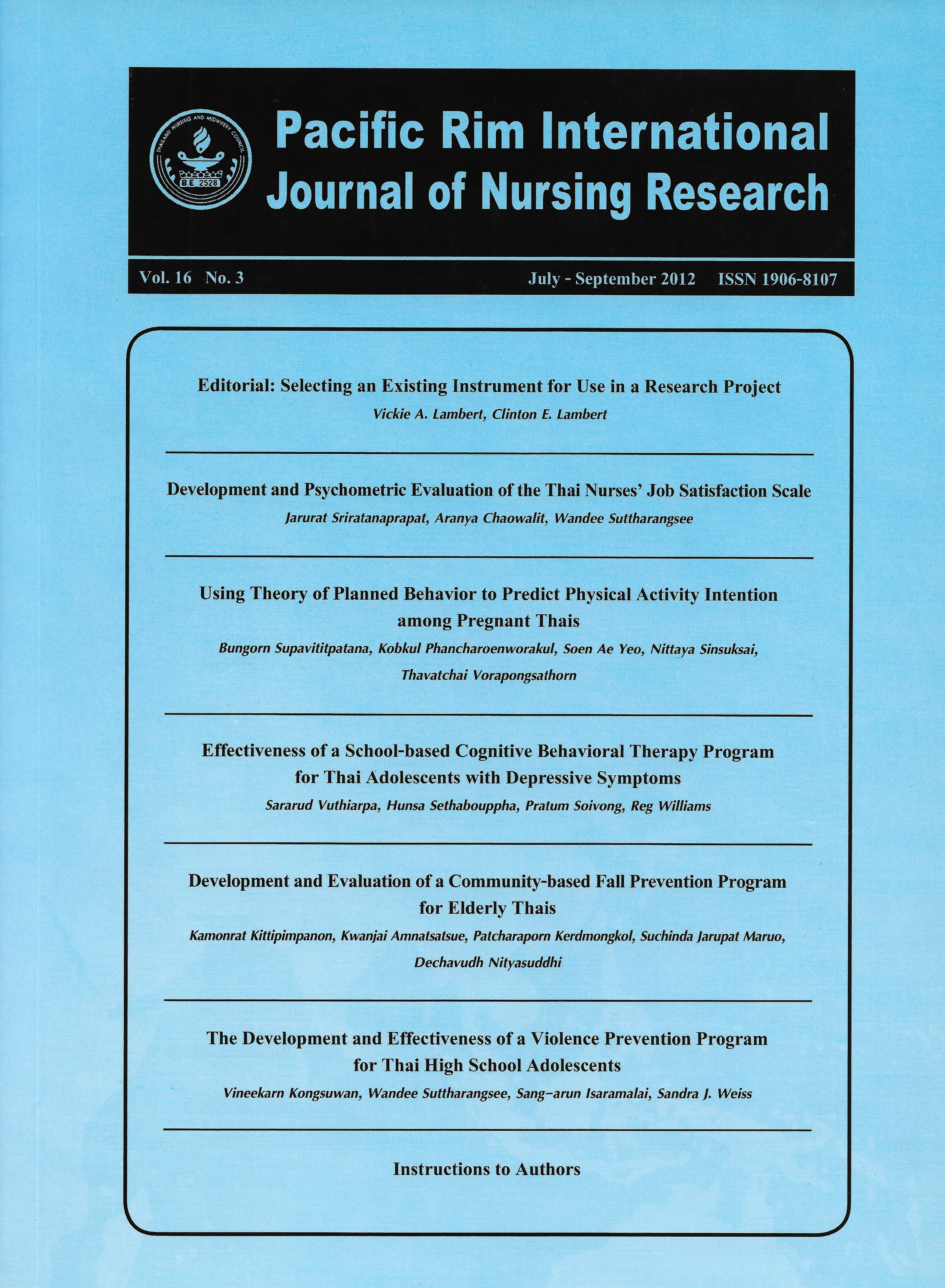Development and Evaluation of a Community-based Fall Prevention Program for Elderly Thais
Keywords:
รูปแบบการป้องกันการหกล้มโดยใช้ชุมชนเป็นฐาน, ผู้สูงอายุไทย, ชุมชนเมือง, วิจัยเชิงปฏิบัติการ, Community-based fall prevention program, Elderly Thais, Urban community, Action researchAbstract
บทคัดย่อ
การวิจัยครั้งนี้เป็นการวิจัยเชิงปฏิบัติการเพื่อพัฒนาและศึกษาผลของการพัฒนารูปแบบการป้องกันการพลัดตกหกล้มของผู้สูงอายุที่อาศัยอยู่ในเขตเมืองกรุงเทพมหานคร โดยใช้ชุมชนเป็นฐาน การเก็บรวบรวมข้อมูลประกอบด้วยข้อมูลเชิงปริมาณและเชิงคุณภาพ แบ่งออกเป็น 4 ระยะ คือ 1) การวิเคราะห์สถานการณ์การหกล้ม 2) การพัฒนารูปแบบการป้องกันการหกล้ม 3) การดำ เนินกิจกรรม และ 4) การประเมินผล
รูปแบบการป้องกันการพลัดตกหกล้มของผู้สูงอายุ โดยใช้ชุมชนเป็นฐาน ใช้การมีส่วนร่วมของชุมชนและแบบจำลอง PRECEDE-PROCEED เป็นกรอบแนวคิด โดยรูปแบบเป็นการจัดการหลายปัจจัย ประกอบด้วย1) การรณรงค์ป้องกันการหกล้มของผู้สูงอายุในชุมชน 2) การประเมินความเสี่ยงต่อการหกล้มหลายปัจจัย 3)การให้ความรู้ 4) การออกกำลังกายเพื่อเพิ่มความสามารถในการทรงตัว 5) การเยี่ยมบ้านเพื่อดูแลการใช้ยาและสิ่งแวดล้อมภายในบ้าน และ 6) การสร้างระบบในการป้องกันการหกล้มในชุมชน
ประสิทธิผลของรูปแบบการป้องกันการพลัดตกหกล้ม ประเมินจากอัตราการเกิดการพลัดตกหกล้มพฤติกรรมการป้องกันการหกล้ม สมรรถภาพทางกาย การมีส่วนร่วมของชุมชน ความพึงพอใจของโปรแกรมของผู้สูงอายุและผู้มีส่วนได้ส่วนเสียก่อนและหลังเข้าร่วมโครงการ โดยใช้สถิติ Paired T-Test ทดสอบความแตกต่างของพฤติกรรมการป้องกันการหกล้ม และ สถิติ Wilcoxon Signed Rank Test ทดสอบความแตกต่างของสมรรถภาพกาย และสถิติบรรยายเพื่อวิเคราะห์ การเปลี่ยนแปลงของอัตราการเกิดการหกล้ม การปรับเปลี่ยนสิ่งแวดล้อม การมีส่วนร่วมของชุมชน และความพึงพอใจต่อโปรแกรมของผู้สูงอายุและเครือข่าย
ภายหลังเข้าร่วมโครงการ พบว่า อัตราการเกิดหกล้มของผู้สูงอายุในชุมชนลดลงร้อยละ 24.56 ผู้สูงอายุที่เข้าร่วมโครงการมีพฤติกรรรมในการป้องกันการหกล้มดี และมีสมรรถภาพทางกายดีขึ้น การปรับสิ่งแวดล้อมที่เสี่ยงภายในบ้าน ได้แก่ การใช้แผ่นกันลื่น การพ่นสีบริเวณพื้นต่างระดับ และการปรับเปลี่ยนโถส้วม และการปรับเปลี่ยนสิ่งแวดล้อมในชุมชนประกอบด้วย การติดป้ายเตือนบริเวณที่เสี่ยง และรายงานหน่วยงานที่รับผิดชอบทราบเพื่อแก้ไข การดำเนินงานพบว่าชุมชนและเครือข่ายมีส่วนร่วมในโครงการอย่างสม่ำเสมอ ผู้สูงอายุและเครือข่ายทีความพึงพอใจต่อรูปแบบการป้องกันการหกล้มในระดับสูง ซึ่งสนับสนุนว่ารูปแบบการป้องกันการหกล้มในผู้สูงอายุที่พัฒนาขึ้นมีประสิทธิผลในการป้องกันกันการหกล้มของผู้สูงอายุไทยในชุมชน
คำสำคัญ: รูปแบบการป้องกันการหกล้มโดยใช้ชุมชนเป็นฐาน; ผู้สูงอายุไทย; ชุมชนเมือง; วิจัยเชิงปฏิบัติการ
Abstract
This action research was conducted to develop a community-based fall prevention programfor elderly Thais, living in an urban Bangkok community, and to evaluate the program's effectiveness.Qualitative and quantitative data were collected via a four-phase plan that included: situation analysisof falls; program development; program implementation; and, program evaluation. The community-basedfall prevention program was based on community participation and a PRECEDE-PROCEED framework,as a multi-factorial intervention, that consisted of: a fall campaign; multi-factorial risk assessment; falleducation; a balance/exercise program; home visits for medication review and home hazard management;and, a fall management system.
All qualitative data were evaluated via content analysis. Effectiveness of the fall preventionprogram (quantitative data) was evaluated in terms of: changes in the incidence of elderly falls;changes in elders’ fall prevention behaviors; changes in elders’ physical performance; modification ofenvironmental hazards; community stakeholders’ participation; and, elders’ and community stakeholders’satisfaction with the program. A paired t-test was used to examine the difference in mean scores offall prevention behaviors, while the Wilcoxon Signed Rank Test was used to examine differences inphysical performance. Descriptive statistics were used to examine: changes in fall incidence; modificationsof environmental hazards; level of community stakeholders’ participation; and, elders’ and communitystakeholders’ satisfaction with the program.
After implementation of the fall prevention program, elders’ fall incidence was reduced 24.86%.In addition, within the same time frame, the elders’ fall prevention behaviors improved, as did theirphysical performance. Modifications made to home environmental hazards included: use of anti-slipmats in the bathroom; spraying different colors on steps and doorsills to enhance their presence; and,changing the style of toilet. Modifications made to community environmental hazards included: postingwarning signs around hazardous areas; and, notifying the organizations responsible for making correctionsto hazardous areas within the community. The level of stakeholders’ participation with each otherwas found to be consistent. The elders and the community stakeholders were highly satisfied with thefall prevention program. Thus, the findings suggested the community-based fall prevention programwas an effective intervention.
Keywords: Community-based fall prevention program; Elderly Thais; Urban community; Action research
Downloads
How to Cite
Issue
Section
License
Copyright: The Pacific Rim International Journal of Nursing Research, Thailand Nursing & Midwifery Council has exclusive rights to publish, reproduce and distribute the manuscript and all contents therein.








.png)



